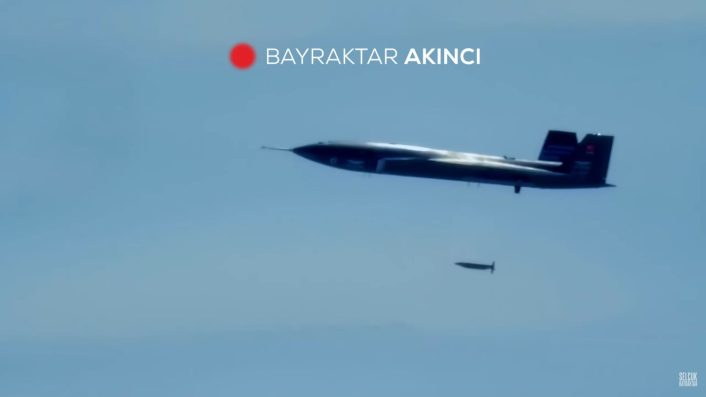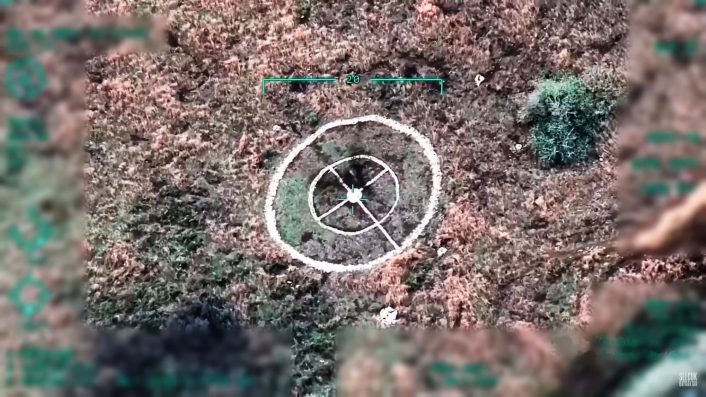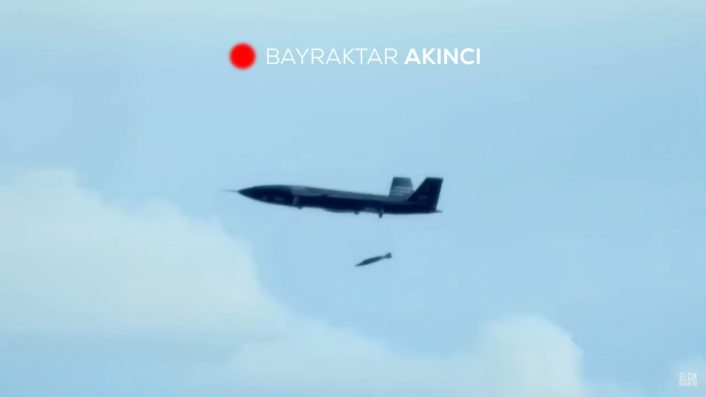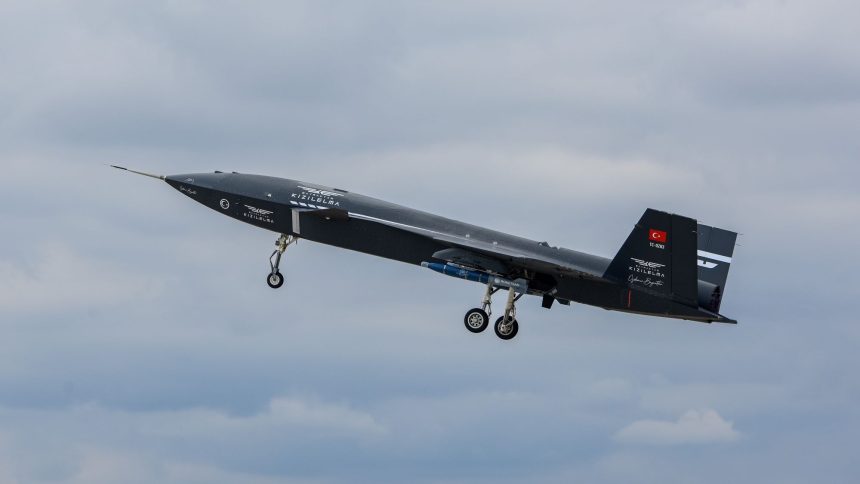Kizilelma’s live-fire tests come within days of the carriage trials with the TOLUN and TEBER-82 munitions.
Baykar’s Kizilelma UCAV recorded another milestone when it dropped two inert munitions, the TOLUN glide bomb and the TEBER-82 guided bomb, in its first live-fire test, the Turkish drone major announced on Oct. 8, 2025. The new milestone comes immediately after the carriage trials conducted between late September and early October.
The video released by the company showed the Kizilelma prototype, TC-OZB3 (the third prototype or PT-3), flying two different sorties for each of the munition types from the Flight Training and Test Center in Çorlu. The drone carried a single TOLUN on a SADAK-4T quad rack on the port-side wing and one TEBER-82 on each of the wings.
Both the weapons, which are inert rounds, struck the marked target on the ground after a ground controller commanded their release from the multi-screen console. The hits triggered a wave of celebration and jubilation each time in the control room.
The video also showed footage from the Electro-Optical (EO) system of an Akinci UCAV during both the flights, which is always used to record Kizilelma’s flights. The rapid progress of the aircraft comes as Italian military and political leadership and representatives from Leonardo visited Baykar’s Bayraktar National Technology Center on Oct. 6, where they were shown demonstrations of the Kizilelma and the Akinci. The two companies created a 50:50 Joint Venture, LBA Systems, after Baykar acquired Italy’s Piaggio Aerospace.
🛡️🇹🇷KIZILELMA project, launched in 2021 with Baykar’s 100% own equity. With the high situational awareness it gains through its AESA radar, it will be able to carry out the most challenging missions.
🔗https://t.co/cFoXGAvMFQ https://t.co/xL1QCBrJPo pic.twitter.com/Zqm0erMQrZ
— Defence Turk English (@Defence_Turk_EN) October 9, 2025
TOLUN and TEBER-82
Aselsan’s TOLUN was first integrated with the Akinci in 2022, following which the company also integrated the SADAK-4T Smart Pneumatic Quad Rack to carry four pieces of the munition. The TOLUN uses GPS/INS guidance against soft and hardened targets. Its warhead is designed by Tübitak SAGE.
On Aug. 9, 2024, the TOLUN bomb was released by the Akinci UCAV on a floating target at sea. Then, on Jan. 13, 2025, an ANKA III UCAV dropped it from its internal bays for the first time. Prior to the release of the TOLUN from the internal bays, the ANKA III completed its first armed flights with a TEBER-82 on Sep. 1, 2024, carrying the guided munition on its left wing.
Aselsan is also developing an IIR (Imaging Infrared) seeker variant to hit moving targets and an unnamed “ground-launched version with Delta-V’s hybrid fuel rocket motor”. The former will use a pod to keep the pilot “in the loop.”
The ground launched variant suggests launch by an MLRS (Multiple Rocket Launch System) like the TRG-230. This is similar to the U.S.-made GLSDB (Ground-Launched Small Diameter Bomb), that fires the modified GBU-39 SDB from the HIMARS (High Mobility Artillery Rocket System).

The TEBER kit, similar to the JDAMs, is described as a “Winged Guidance Kit”, that transforms Mk-81 and Mk-82 bombs into guided munitions with dual laser and GPS-guidance.
Future as a CCA for both GCAP and Turkey
The live-fire trials with TOLUN and TEBER-82 appear to suggest the Kizilelma, which has primarily been billed as a collaborative combat loyal wingman for the indigenous Kaan fighter, would also have an air to ground utility. The Kizilelma was displayed during July 2025’s IDEF25 exhibition with Aselasan’s ARAT 100 IRST (Infrared Search and Track) on top of the nose and the TOYGUN 100 EOTS (Electro-Optical Tracking System) under the chin, suggesting the configuration is meant for future prototypes or production models.
So far, we are yet to see the Kizilelma being tested in captive carry trials of the Turkish Bozdoğan (short-range) and Gökdoğan (beyond visual-range) AAMs, more consistent with its aerial combat UCAV role. Additionally, previous statements by Leonardo and Baykar officials have directly both hinted and mentioned CCAs for future sixth generation jets being one of the “challenges” on which the two companies would work on.

The ability to fire air-to-grounds munitions could also be leveraged for SEAD/DEAD (Suppression/Destruction of Enemy Air Defense) roles, with many notional CCA concept renditions envisaged for that mission. The ANKA III UCAV, which is also planned as CCA for the Kaan, has been photographed with multirole munitions like the Şimşek (Lightning) and higher-performance Süper Şimşek (Super Lightning).
Some Turkish defense pages have said it could be used for radar-killing roles. However, we are far from knowing if that munition will be integrated with the Kizilelma.
If not classic AAM or SEAD/DEAD munitions, the Kizilelma could deploy other smaller and cheaper decoy drones, roughly the size of the TOLUN, meant to swarm and overwhelm adversary radars. Or, the TOLUN itself could be used for SEAD/DEAD roles, if Aselsan also decides to develop a version with a radio-frequency seeker.
The U.K., Italy and Japan would nevertheless need to rapidly field a CCA design for their GCAP concept, the first demonstrator of which is planned to fly by 2027. A ready design significantly cuts development and fielding timelines, especially as the future of the competing French-German-Spanish FCAS (Future Combat Air System) looks bleak.

Turkey’s rise
The strong possibility of the Kizilelma, or at least a heavily “Europeanized” derivative, flying alongside the GCAP fighter in the future cannot be ruled out. Turkey is also laying the foundations of an emerging defense-commercial relationship with Japan, another GCAP member nation.
This however could be a separate project from the GCAP, and instead merely be Tokyo’s pursuit of alternative and cheaper MALE and HALE-class drones for its vast maritime swathes in the western Pacific. Late in September, Turkish foreign minister Hakan Fidan’s also claimed that U.S. officials informally asked if Baykar could open a drone production facility in the U.S. ahead of the meeting between Presidents Donald Trump and Recep Tayyip Erdogan.
KIZILELMA ilk atış testinde hedefi 12’den vurdu https://t.co/Nmqc5EmXcL @BaykarTech pic.twitter.com/vvbWGlGc80
— tolgaozbekcom (@tolgaozbek_com) October 9, 2025
Ankara’s stunning rise as an aerospace and drone power has accorded it the honor of being a smaller middle power gaining inroads into the highly protected military markets of the G7 countries.









